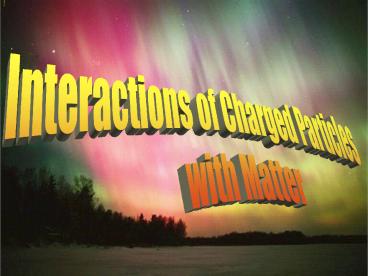Interaction of Charged Particles with Matter - PowerPoint PPT Presentation
1 / 18
Title: Interaction of Charged Particles with Matter
1
Interaction of Charged Particles with Matter
Interactions of Charged Particles with Matter
2
Literature/Tutorials
James Ziegler
3
Stopping and Range Tables for Charged Particles
J.F. Ziegler (IBMJ.P. Biersack
(HMI)) http//www.srim.org
Older Literature Hubert et al., Ann. De Physique
Suppl.5, 1 (1980)
4
Main Interactions of Charged Particles
Collisions with nuclei
Most interactions of charged particles with
material components are collisions with atomic
electrons. Nuclear collisions are noticeable only
at low kinetic energies.
5
Stochastic Multiple Scattering and Straggling
U ions, 60 keV, straggling in range and angle
Target of layers (absorbers Be, Au, Si)
Range is diffuse Range straggling
Probability
Range (Å)
6
Range and Stopping Power
Scattering angle qs path variable s Stochastic
multiple scattering process produces straggling
in range, energy loss, angle
Range
Stopping power
- Path length of trajectory
7
Phenomenological Model Of Energy Loss in Matter
- Bethe et al. (1930-1953), Lindhardts electron
theory Describes energy loss through ionization,
incoming ions are fully stripped
Estimate of trends/Order of magnitude Eparticle
kinetic energy, e- ? at rest
Important only forces ? to trajectory, others
cancel
8
Phenomenological Model of Energy Loss in Matter
- Integrate over radial coordinate
Estimate of radial limits Ne e- density le
electronic wave length, IEionization energy
9
Phenomenological Model Of Energy Loss in Matter
- Further
Insert r atomic density, ZT atomic number of
target Ne ZT r
10
Bethe-Bloch Equation
- Quantum mechanical calculation (for heavy
particles Mme)
- atomic density
- ZT atomic number of target
- AT mass number of target
11
Theoretical E-Loss Curves
- Units MeV/Nucleon
- LossMeV/A per mg/cm2
- Bragg maximum
- Semi-quantitative only Expt values smaller both
at small and large energies - ? recharging effects for projectile
Mg
He
MathCad Program
12
Stopping Power Isotopic Scaling Laws
Describes well the difference of R for different
isotopes of a given element, but
R(Be)/R(Ar)2.97 expt 4.67 theo Zeff t Zp
effective charge
13
Theory and Practice for Very Heavy Ions
Theoretical energy loss in material of finite
thickness is obtained from integration of the
Bethe-Bloch formula or equivalent. Actual data
may differ Calibration required
Energy lost by various ions in a 15.9 mm Si
transmission detector vs. ion energy per nucleon
(mass number A). Curves represent different
theories.
14
Range and Specific Ionization
E-loss in Air 1atm, 150C
Stopping power dE/dx (specific energy loss)
depends on energy E and therefore on x
Bragg Curve
Highest E loss close to end of path ? Bragg
maximum
Main E-loss mechanism ionization, production of
d electrons, electron-ion pairs
15
Transmission Functions
Absorber
Transmission T(x) N(x)/N0
Heavy particles (a, p,..HI) have a well defined
range, R(E). Multiple scattering at small angles
only, because of M gtgt me Light particles
(electrons) and photons are scattered off
original path by large angles Range is not well
defined
a2
a1
e1
e2
16
Energy Loss Distributions
- Absorber of thickness x (r, ZT, AT), many
statistical scattering events - ? Central Limit Theorem Gaussian distribution in
energy loss DE
Thin absorber Asymmetric tail towards higher DE
17
Angular Straggling
Theory by Moliere, see W.T. Scott, Rev. Mod.
Phys. 35, 231 (1963) HI M. Wong et al., Med.
Phys. 17, 163 (1990)
Non-trivial geometry !
Assume multiple Coulomb scattering Gaussian
angular distribution
18
End































